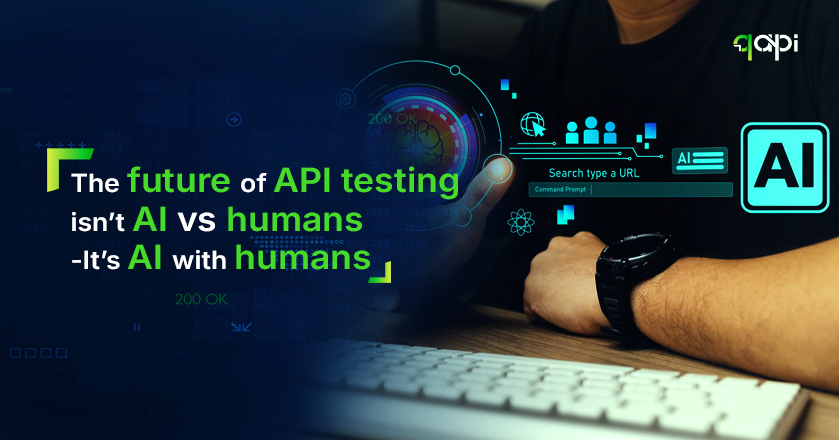Is AI a gamechanger? Yes, it is replacing some jobs, but not for API testing. In fact, it’s the best opportunity to leverage AI and step ahead of the competition.
If you’re like most developers, testers, QA engineers, you’ve read the subreddits, and stack overflow comments then you know the space we are in right now.
The way teams approach testing has fundamentally changed. Ten years ago, testing was a checkpoint—a stage that happened before a release went live.
Ten years ago, is a long shot, just compare it with the scenario three years ago.
Today, in a world where APIs connect nearly every experience, testing has become the oil that keeps the engine(products) moving forward without breaking.
APIs isn’t just a supporting asset anymore; they are the product. A single broken endpoint can stall your application, interrupt a login, and derail an entire workflow. In a time where users expect(want!) seamless digital experiences, the cost of API failure is just too high- frustrated customers, and damaged brand trust.
But here’s the good news: API testing has also evolved. Thanks to automation, integration with CI/CD pipelines, and now artificial intelligence (AI), QA teams no longer need to choose between speed and quality.
If you’re curious and willing to take action, this is the right time to use the tools that don’t require expensive licences or hardcore training. You just a plan on how to use them
With the right approach, you can move fast and build resilient products. qAPI is calling this new playbook as the End-to-End API testing, and anyone can use it. In this guide we’re explaining the new partnership that combines API testing with AI efficiency to grow your business.
At Qyrus, we’ve seen this shift firsthand with qAPI, our AI-powered API testing platform. The most successful teams don’t think of testing as linear— “build, test, release.”
Instead, they work in a loop: setting quality standards, building tests as per real-world behavior, doubling down on automation through CI/CD, and evolving continuously with insights.
This loop doesn’t just catch bugs—it becomes a feedback engine that fuels faster development, better collaboration, and smarter decisions. Let’s explore how it works.
A lot of businesses are missing the important and basic step. The first thing you should do it define the functionality, limitations and performance parameters of your APIs.
Qyrus research shows that nearly 7 out of 10 developers spend 60% of their sprint time only on API testing.
1) Define Upfront
Every strong API testing strategy starts with a foundation. For APIs, that foundation is clarity—clearly stating what “good” looks like before you ever run a test.
The numbers above, shows that lot of people don’t even have an idea on how to use or start building APIs.
It’s easy to fall into the trap of running requests without rules. “Did the API respond?” isn’t enough. It’s because you have always done the same way, so the results have always been the same.
What a lot of those teams do not realize is it can be resolved easily with a relatively inexpensive AI tool and a good strategy in place. Everyone has access to the same AI tools. You and your team only need the context and perspectives about your business that can make a difference.
With qAPI, teams can import OpenAPI or Postman collections and immediately layer in schema validations and assertions without worrying about scripting. Instead of plain checks, every endpoint now has defined rules. For example:
• The 200 OK status code is not just a success—it must return a JSON response that matches the schema.
• The login endpoint must respond within 300ms or it’s flagged as a performance issue.
• The checkout flow must return a valid transaction ID every time, across all environments.
Tokens, variables, and parameters make it easy to handle credentials and environments. That means you’re not just testing with hardcoded data—you’re validating real-world conditions.
💡 Think of this step as drawing the map. Without it, your tests may run, but you’ll never know if you’re heading in the right direction.
2) Tailor: Make Tests Match Reality
The next step is to test your APIs the right way.
Here’s the truth: APIs rarely fail in isolation.
More than you realize, issues come from workflows—multi-step processes where one bad call creates bigger failures. A payment might succeed, but if the confirmation email isn’t received in within 5 minutes, you’ve lost the customer.
That’s why the second loop stage is about tailoring tests to recreate real-world journeys.
In qAPI, you can create customized process tests that lets you chain requests together to simulate how users actually interact with your product. You can validate:
• Business logic (e.g., a discount applies correctly at checkout).
• Dependency chains (e.g., user authentication before data retrieval).
• 3rd-party services (e.g., shipping APIs, payment gateways).
This gives you confidence not just in endpoints, but in entire flows.
And here’s where AI steps in: qAPI’s Automap feature automatically discovers endpoints by mapping interactions, while it can also create workflows automatically expand your coverage without hours of manual work.
Instead of writing rules line by line, qAPI suggests validation points based on actual traffic and expected behavior. The good thing here is that instead of making guesses about thousands of people, you can simulate users and understand how your APIs perform under different conditions.
3) Simplify: Automate Across Your Pipeline
You might be thinking, “I can just run some tests locally on different tools” use the setup as it is, but you can do a lot better now.
A loop is only as strong as its motion. For API testing, that motion comes from automation—ensuring tests run continuously, not just when someone remembers to hit “run.”
While most of you might be confused as you have been running automated tests but, AI automation will give you a lot than you ask.
Too often, teams run tests locally, find issues late, and scramble before release. But the best teams integrate API testing directly into their CI/CD pipeline.
With qAPI, you can:
• Run tests automatically in Jenkins, Azure DevOps.
• Run suites per branch, per environment, and per release stage.
• Block problematic merges with quality gates that stop regressions from moving ahead.
This will not just reduce risk—it will build trust. Developers know their code won’t break critical APIs because the system won’t allow it. QA teams can shift from being gatekeepers to enablers, helping releases move faster while protecting quality.
4) Evolve: Learn Faster with AI + Reporting
The final stage of the loop—and arguably the most important—is learning.
This means caring about how your business shows up in the market. Think about it from a consumer’s perspective:
• A traveler is trying to book a ticket. The airline API must confirm seat availability, validate payment, and issue an e-ticket—within seconds.
• A shopper is buying a sofa online. Multiple APIs come into play: product catalog, pricing, payment gateway, shipping provider, even inventory checks in real time.
• Even something as simple as logging in or resetting a password relies on authentication APIs working flawlessly.
This is where AI shines. In qAPI, you don’t just see what passed or failed—you get AI-generated workflow summaries that explain what happened in plain language. That means:
• A developer new to the project can instantly understand a complex flow.
• A product manager can review test outcomes without diving into logs.
• A QA lead can spot gaps in assertions or flaky tests immediately.
Beyond summaries, qAPI reports include runtime stats, detailed charts, and insights that feed directly back into the first loop stage. You’re not just closing tickets—you’re closing the loop by improving future tests.
With qAPI’s reporting features, teams get a full picture of API performance and reliability:
Detailed endpoint-level insights show you exactly which APIs are healthy, which are slow, and which are returning unexpected responses.
Downloadable reports make it easy to share results across teams and stakeholders, so developers, testers, and product managers all see the same truth.
AI-generated workflow summaries translate complex test outcomes into plain language, helping teams quickly spot gaps in coverage or areas of risk.
How to Connect qAPI (Quick Start)
If you’re ready to try the API Testing Loop in your own team, here’s a simple path:
• Create a workspace → Import APIs from OpenAPI, Postman, or WSDL.
• Set environments → Store variables, tokens, and secrets.
• Build functional + process tests → Use schema/response assertions and AI-assisted discovery.
• Automate with CI/CD → Run tests via Jenkins, Azure, or TeamCity pipelines; block failing builds.
• Review, summarize, iterate → Use AI-powered summaries and reports to evolve tests with each cycle.
Need a helping hand? Watch this video
Why the API Testing Loop Will Work?
The API Testing Loop isn’t just a methodology—it’s a mindset. We have seen it making things possible for our client’s. Here’s why it delivers results:
• Shared understanding – Explicit contracts and AI-generated summaries align developers, QA, and product teams.
• Real-world coverage – Process testing ensures you’re validating the workflows users experience.
• Consistency at speed – CI/CD integration guarantees that testing isn’t an afterthought—it’s built into every release.
When these elements work together, testing stops being a bottleneck. Instead, it becomes a growth engine—powering faster shipping, better quality, and more resilient software.
Closing Thought
The future of API testing isn’t about running more tests—it’s about running smarter loops. By blending AI with automation, qAPI helps teams test in a way that’s continuous, contextual, and collaborative.
The shift is already happening. Teams that embrace the loop are finding they can move faster, reduce risk, and build products users’ trust. Teams that don’t risk being left behind.
So, the real question isn’t if you should adopt an API Testing Loop. It’s when. And the sooner you start, the sooner you’ll ship with confidence—on every commit.
Ready to see how qAPI can power your loop? Get started here.

